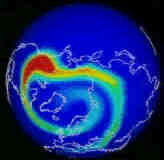Contrails - Research, comments and links
Contrails and Aviation-cirrus
Climate (04)
| Air
travel to knock UK CO2 emissions off target
|
|
UK:
February 14, 2003
LONDON - Britain is unlikely to deliver on its pledges to curb emissions of carbon dioxide, with pollution from air travel threatening to undo progress by industry and other sectors, said a team of government advisors this week. |
The independent Sustainable Development Commission said existing measures to cut emissions of greenhouse gas carbon dioxide (CO2) were unlikely to achieve even two thirds of the government's targets, and maybe less than half. The government's goal is to cut CO2 emissions by 20 percent from 1990 levels by 2010. "Our analysis shows that the UK will fall well short of the government's goal for reducing emissions of carbon dioxide, the principal greenhouse gas, unless further measures are taken," said commission chairman Jonathon Porritt.Particularly worrying were emissions from air travel, which had been excluded from government calculations and were putting at risk targets set out in the government's 10-year transport plan, said the commission. Porritt urged ministers to use a white paper on future energy policy, due shortly, to put in place extra measures.The government is banking on renewable energy sources such as wind turbines, as well as increased energy efficiency, to bring big reductions in emissions. Britain was on track to meet targets on total greenhouse gas emissions set out in the Kyoto Protocol, the commission said.Under Kyoto, the UK is committed to cutting total greenhouse gas emissions by 12.5 percent from 1990 levels over the period 2008-2012. Source: https://www.planetark.org/dailynewsstory.cfm/newsid/19821/story.htm |
REUTERS NEWS SERVICE |
Impact des avions sur l'atmosph�re
impact global
Le transport chimique des effluents �mis par les avions est �valu� � l'aide de mod�les r�gionaux et globaux � deux et trois dimensions. On en d�duit leurs effets sur les principaux composants minoritaires de notre atmosph�re tel que l'ozone. Ces �valuations sont r�alis�es � court, moyen et long terme ( 1an, 5 ans et 50 ans).

Advection de traceurs dans l'atmosph�re
(Animation
QuickTime 332 Ko)
https://www.onera.fr/dmph/impact/impactglobal.html
February 25, 2000
-----Original Message-----
From: Chet France [SMTP:BORUSHKO.MARGARET@epamail.epa.gov]
Sent: Friday, February 25, 2000 6:22 AM
[..]
Jet aircraft engines emit tiny particles that serve as condensation nuclei.
High-altitude water vapor collects on these particles, crystallizes, in turn
creating streaks of frozen water vapor, otherwise known as contrails,
from airplanes operating at high altitudes.
Some contrails join with other contrails and expand into huge,
natural-looking clouds of cirrus characteristics that can cover large
areas of the sky. (Cirrus clouds are wispy white, usually a natural
phenomenon, consisting of minute ice crystals formed at high altitudes of 20,000
to
40,000 feet.) Research by the National Aeronautics and Space
Administration (NASA) has recognized this process of jet aircraft cloud
formation as a
potential problem for blocking sunlight, but not solar heat reaching the
earth, thereby acting as a thermal blanket and perhaps contributing to
global warming. A 1999 report issued by the Intergovernmental Panel on Climate
Change, entitled, Aviation and the Global Atmosphere, discusses contrail
formation and its effects in more detail. A copy of this report (ISBN
number 0 521 66300 8) may be ordered through Cambridge University Press*
website at www.cup.org. The influence of contrails on cirrus clouds is
noted as a key area of scientific uncertainty that limits the ability to
project aviation impacts on climate and ozone. Further work is required
to reduce scientific and other uncertainties of aviation impacts. EPA and
the Federal Aviation Administration (FAA) fully support continued research
to address these issues.
In regard to air quality impacts, although jet aircraft
contribute much less air pollution than that from motor vehicles, their overall
emissions are increasing every year as air travel becomes more popular.
In addition, jet aircraft can contribute significantly to ground-level
ambient air pollution in the immediate vicinity of an airport, especially
emissions of oxides of nitrogen (NOx) and hydrocarbons (HCs) which contribute to
the formation of ozone. Additional, detailed information on aircraft
emissions can be found in a recently published EPA Office of Mobile Sources
(OMS)
report, Evaluation of Air Pollutant Emissions from Subsonic Commercial
Jet Aircraft, April 1999. This report is available at OMS* Aviation
Emissions web site (www.epa.gov/oms/aviation.htm). It provides an estimation of
the contribution of aircraft to air quality emissions in ten urban areas.
The aircraft emission standards for gas turbine (jet) engines
which power civil aircraft have been in place for about twenty years.
Before an engine type can be sold or installed on an aircraft, the
manufacturer must test its emissions on the ground by simulating in-use
conditions. EPA sets the emission standards for the engines, and the
FAA monitors the certification process and enforces the standards. Emission
standards apply to essentially all commercial aircraft, comprising
scheduled and freight airlines. Two classes of aircraft, military and
general aviation, are presently not covered. Controls on engine smoke
and prohibitions on fuel venting were instituted in 1974 and have been
revised several times since then. Beginning in 1984, limits were placed on the
amount of unburned HCs * also termed volatile organic compounds (VOCs) *
which turbine engines can emit per landing and takeoff cycle. In May of
1997, EPA adopted the current emission standards for gas turbine engines
of the International Civil Aviation Organization (ICAO) for NOx and carbon
monoxide (CO). In addition, in the near future, EPA plans to adopt the
more stringent NOx standards expected to be formally accepted by ICAO
later this year, for implementation in 2004.
EPA is committed and working to reduce emissions from jet
engine exhaust. I hope this letter will help answer your questions. Please
feel free to contact us if you have any further questions.
Sincerely,
Chester J. France, Director
Assessment and Standards Division .
Source: https://www.carnicom.com/epa4.htm
